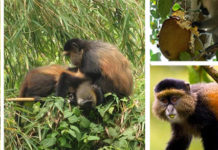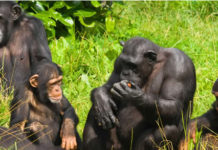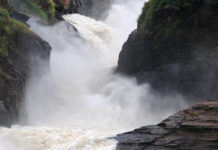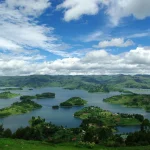Kidepo Valley National park is one of Uganda’s most isolated and fabulous national parks. The park covers 1,442 square kilometers in the rugged, semi-arid valleys of Karamoja region on the far northern Eastern part of Uganda on the border with Sudan. The park has a scenery unmatched to any other park in East Africa as well as great numbers of plant and animal species. Kidepo vegetation is of open tree Savannah varying much in structure, size and composition. Mountain forests take over some of the high places, while areas along the Lorupei River support thick Acacia geradi forests. The ideal time for visiting the park is March-April for all the specials and many transit migrants. But visiting is good for all year-round visiting and a tour would roughly take 4-7 days to optimally exploit all the trip activities in the park.
Key Bird Species.
For birders, the park has over 475 species, the second largest number next to Queen Elizabeth National Park. Birds like the black-breasted barbet and Karamoja Apallis, amongst the Great Lakes Region’s most rare species, are mostly seen at the park. The park is naturally gifted with a number of birds that can provide great times watching by any holiday-maker. These include Ostrich, African Swallow-tailed Kite, Eastern Pale Chanting Goshawk, Pygmy Falcon, Fox Kestrel, Stone Partridge, Clapperton’s and Heuglin’s Francolins, Yellow-necked Spurfowl, Kori, White-bellied and Hartlaub’s Bustards, Eastern Yellow and Jackson’s Hornbills Violet-tipped Courser, Black-headed Plover, Four-banded Sand Grouse, Bruce’s Green Pigeon and Rose-ringed Parakeet.
The park also has the white-crested turaco, White-bellied Go-away bird, White-faced Scoops Owl, Isabelline and Heuglin’s Wheaters, Long-tailed and Standard-winged Nightjars, Little Green Bee-eater, Abyssinian and Rufous-crowned Rollers, Foxy and Red pate Cisticolas, Abyssinian Ground, , Red-fronted and Black-breasted Barbets, Brown-backed Woodpecker, Singing Bush lark, Red-winged Lark, Ethiopian Swallow, Pied, African Grey Flycatcher, Karamoja Apalis, White-bellied Tit, Mouse-coloured Penduline Tit, Northern White-crowned and Yellow-billed Shrikes, Slate-coloured Boubou and Fan-tailed Raven
Others that cannot jump a visitors sight include superb starling, Red billed Oxpecker, Eastern Violet backed, Pygmy and Beautiful Sunbirds, Rufous and Chestnut Sparrow, Yellow-spotted Petronia, White-headed and White-billed Buffalo Weavers, White-browed and Chestnut- crowned Sparrow Weavers, Grey-capped Social and Speckle-fronted Weavers, Green-winged, Orange-winged and Red-winged Pytilias, Black-bellied and Black-faded Waxbill, Steel-blue and Straw tailed Whydahs, Brown-rumped Bunting. Kidepo Valley National Park Activities.
Bird watching Kidepo Valley has Apoka Rest Camp and Park Headquarters facing the southern Narus Valley which is a big spot to commence a wonderful Kidepo bird watching. The park boasts an widespread avifauna, 465 species have been recorded (three new species were added to the list in 1995). Of particular interest, the ostrich and the Kori bustard are predominantly associated with waterless regions.The fine-looking Silverbird and small bands of Yellow-billed Shrike common on thorn trees around camp as well as other types like Vinaceous Dove, Hoopoe, Nubian Woodpecker, Mosque Swallow, Ruppell’s and Superb Starlings, Scarlet-chested Sunbird, Little Weaver and Red-cheeked Cordon-bleu. An everlasting water hole at the edging of the camp attracts swallows and an assortment of seed eaters including Yellow-rumped Seed eater. It is warmheartedly visited at night-time by Four-banded Sandgrouse, Elephant, Buffalo and infrequently by Lions. Clapperton’s Francolin, Black Coucal, African Moustached and Broad-tailed Warblers, Marsh Tchagra and Crimson-rumped Waxbill may be seen in the rank grassland along the normally dry watercourse neighbouring to the camp or along the pathway to Apoka lodge.
Animals to watch
Kidepo Valley National Park has about 80 species of mammals 28 out of which are as well found in other National Parks Uganda. Among them are bat-eared fox, carcal, cheetah and Klipspringer and many more. During President Idi Amin regime (1971-1979), Kidepo like many other Ugandan National Parks suffered much as many animals were killed due to poaching which left many game herds depleted, meaning that the park is still recovering. Mammals including Elephant, Common Zebra, warthog, Cape buffalo, bush pig, Rothschild giraffe, Bohor Reedbuck, eland, bush buck, bush duskier, reed buck, Jackson’s hartebeest, oribi, defassa Waterbucks and Kongoni have exposed a notable raise in numbers. Carnivore species or ppredators unique to Kidepo and Karamoja region include the spotted Hyenas, Leopard, Lion, bat-eared fox, aardwolf, caracal, cheetah, hunting dog, black-backed jackal and side-striped jackal plus many others that are commonly seen in the park. The Narus Valley has Oribis in masses and the Guenther’s Dik Dik are all over the place in the dry thorn wood in the north. Senegal Galago and Side stripy Jackal may be found in the rest camp at night and White-tailed Mongoose is common but more probable to be found on a night drive. Reptiles are also somewhat common in the park. Of the 80 species of mammals listed in 1971, 28 were not identified to occur in any other Ugandan national park.
Hiking and Scenery viewing
Hiking can be made on Lamoj Mountains a not many kilometers from the Park Headquarters. Visitors can also go to view the fabulous Kidepo River Valley dominated by Borassus palm forest; it has a large flat bed that is dry for most of the year. From Kidepo Valley, you may also visit the Kanangorok Hot Springs, which are situated only 11 km from Kidepo river valley. The mountain and Savannah scenery of the park is fantastic. The Narus valley is situated in the South West of the park; the rough Napore-Nyagia mountain range forms its western frontier. Separating it from the Kidepo Valley in the northeast, are the Natira and Lokayot Hills. To the north in the Sudan are the Lotukei Mountains and the Morungole range marks the southern edge of the park.
Traditional Cultural Performances Communities near the park stage cultural dances and performances. Dances like Emuya of the Naporre and Nyangia, Larakaraka and Apiti dances of the Acholi are common and worth seeing or participate in if you so wish. Cultural visits and nature walk to the Karamajong manyattas (homesteads) where you can see kraals local communities’ livestock, traditional costume, stools, spears headdress, knives, bows, arrows and jewellery to mention make a the whole enjoyable and memorable. Visiting the splendid Kidepo River Valley dominated by Borassus palm forest is another good experience. Kanangorok Hot Springs, located only 11 kilometers from Kidepo river valley is a must-visit. Picnicking from the sand is also there.
Picnic at Kidepo
As you visit Kidepo River, spare time and visit the picnic site situated on the sand and you will not fail to hear the sound of palm leaves in a continuous movement in the wind.
Accommodations at Kidepo National Park
1. Apoka Rest Camp overlooking the Narus Valley with comfortable rooms are always available.
2. National Park Bandas at Apoka have items like bedding, mosquito netting, hot showers, fresh drinking water and firewood. It is recommended to carry your own food for your personal preparation or can be cooked for you if you so wish. Camp shop has various types of beverages.
3. The Kakine Campsite, it’s a small distance from Apoka. This campsite has firewood and clean drinking water. Upon arrival at Apoka Rest Camp you can get a ranger-guide to go along with you all over while at the park. A ranger knows many of the bird species. Meals: The Rest Camp or hostel do not stock food, so visitors are for that reason advised to carry enough food and drinks for the period of their stay in the park.
The Rest Camp staff can arrange for the cooking. However other additional diet such as chicken and goat meat can be arranged from the nearby areas for visitors who intend to stay for a longer time.
GOING TO KIDEPO VALLEY NATIONAL PARK
A tourist can use road or air transport. By and large from Kampala, a drive goes covers a distance in about in 11-hours in which 4Wheel Drive vehicles are most suitable.
Going to Kidepo by Road:
Kampala-Jinja-Mbale-Soroti-Moroto-Kidepo-792 km
Kampala-Masindi-Lira-Kotido-Kidepo-705 km
Kampala-Jinja-Mbale-Sironko-Kotido-Kideop-740 km
Kampala-Soroti -Kotido via Amuria 656 km
Driving is more rewarding as vast parts of Karamoja are nice-looking and entirely wilderness. Nevertheless road conditions are sometimes complex and 4-wheel drive vehicles (4WD) are recommended. Visitors should note that the road mainly in use from Kotido to Kaabong passes via Kanawauat.
Travelers who decide to tag along the Soroti-Moroto road will be fascinated by the view of the steep volcano of Alekilek about midway Moroti and Soroti. And for those who take the Lira-Kotido road will enjoy the scenery of the Labwor hills and in particular the massive and bare Alerek (Kidi Rwot) rock about 55 km to Kotido.
Going to Kidepo by Air:
Chartered aircraft are available from Entebbe International Airport to the Park Headoffices. There is an airstrip at Lomej about 3 km south of the Park Headquarters. There are also Chartered aircraft from Kajjanzi to the Park Headquarters. AAB Tours and Travel can arranges for you the best cost-effective air transport means.











